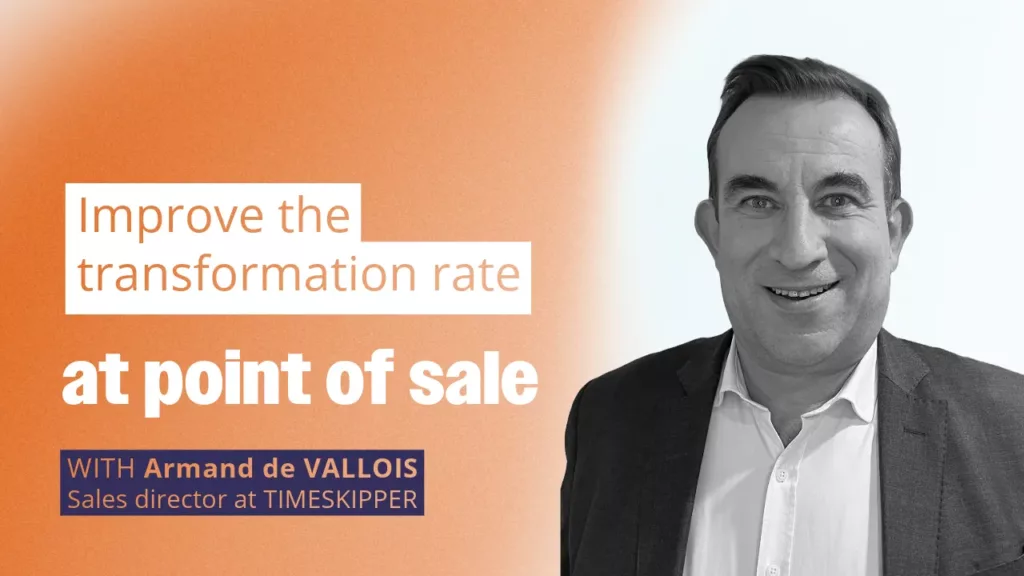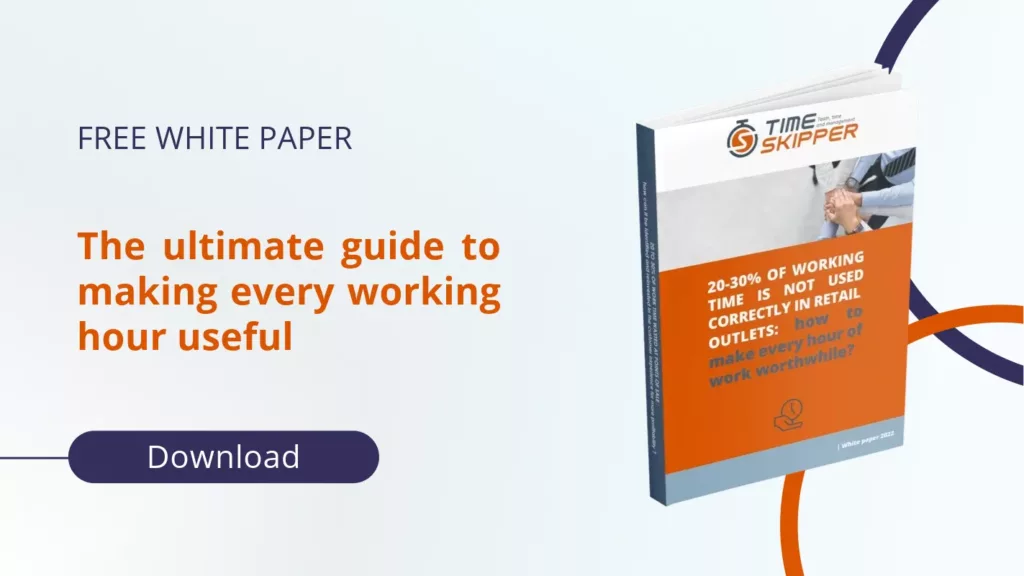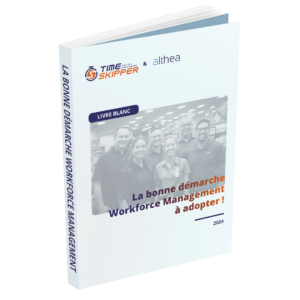Introduction
A prospect enters your store. Will he leave empty-handed or with a well-filled shopping basket? That’s the question the conversion rate answers. To make it work, and effectively transform a visitor into a buyer, nothing is left to chance. It’s a real strategy that varies according to the type of distribution.
As part of a special series on in-store time management with Je Bosse en Grande Distribution, Jonathan interviews Armand, one of our in-store operations experts and sales manager. Here, he shares a ready-to-use strategy for improving your conversion rate, depending on your sector.
I) What is a conversion rate?
Before explaining the strategies you can use to improve your conversion rate, it’s essential to understand what we mean by it.
Very simply, this rate corresponds to the proportion of visitors entering a sales site and making a purchase. We could also call it the “conversion rate”, i.e. the number of prospects converted into buyers.
How to calculate it?
The calculation is very simple.
Simply divide the number of transactions by the total number of visitors and multiply by 100.
For example, if 1,000 prospects visit a sales site in one day and 250 of them make a purchase, the conversion rate is 25%.
Your aim is obviously to achieve the highest possible rate. To achieve this, the store’s appearance, the availability of products and sales staff, the advice given and therefore the customer experience all need to be top-notch. However, it should be noted that, depending on the sector or distribution model, some of these criteria are more important than others.
Let’s take a look.
II) Adapting your conversion strategy to your distribution model
Supermarkets: focus on the attractiveness of the sales site
In self-service stores, sales staff are “invisible”. Making the store attractive, and therefore the customer experience, is essential.
Armand insists on an obvious principle: “make sure that the right product is available at the right time, at the right price and in sufficient quantity”.
In other words, customers must be able to find what they’re looking for directly, without needing any help, and all in a pleasant environment. It’s all about reducing existing irritants. You’re all familiar with them, but they include stock-outs, waiting at the checkout, tidiness and cleanliness, and good labelling and signage.
To illustrate, let’s take a prospect who visits a supermarket. They want to find all the products on their shopping list without a hitch. If a certain breakage rate is acceptable, he expects to find most of the products he wants. He would like the prices displayed to be correct, to avoid unpleasant surprises at the checkout. What’s more, he hopes that he won’t have to struggle to navigate between aisles, and that he won’t have to wait long at the checkout.
To ensure a pleasant shopping experience and that customers leave with the maximum number of products on their shopping list, or even more, thanks to well-designed aisles, we need to ensure rigorous replenishment and, above all, that all irritant-reducing tasks are carried out. A fine-tuned organization of day-to-day activities is essential. Hence the importance of an activity management tool.
The importance of advice in specialized distribution
In specialist stores (DIY, textiles, electronics, etc.), human expertise plays a decisive role in the conversion rate. As Armand points out, “what really makes the difference is the ability of sales staff to welcome, advise and guide customers effectively”. The first thing to do is to ensure that sales staff are not busy with other tasks during customer flows, so as to provide them with the best possible information. Or at least make sure they are doing tasks in the background that they can interrupt at any time to serve and advise the customer.
On the other hand, consumers are now well informed about products before they come to the store, thanks to online sites and reviews. They therefore expect expert advice when they talk to a salesperson. Salespeople must therefore go beyond the information available on the Internet and provide genuine, personalized recommendations that make all the difference.
Training sales staff is essential, but it takes time. Time that can’t be taken up when potential prospects are present. It is therefore essential to set up dedicated slots within the organization. A few ideas include setting up daily mini-training sessions at the start of each shift on a specific product, or in-store “role-playing” during off-peak periods. In this way, they can be trained without leaving the sales floor.
The sales ceremony: A must in the luxury sector
At the extreme end of the retail spectrum, the luxury sector is characterized by a unique, personalized, almost theatrical experience. Here, conversion rates depend on the brand’s ability to offer a memorable experience that goes far beyond a simple sales transaction. “In the luxury sector, we’re no longer just talking about a sale, but a ceremony,” explains Armand. As soon as visitors walk through the doors of a high-end boutique, they receive a personalized welcome and constant support. This is when every detail counts: from the ambience of the store to the meticulous presentation of the products, to the constant, delicate attention of the sales assistant.
An example of this would be a high-end watchmaking boutique, where the consultant personally greets each customer, takes the time to explain the technical features of the watches in detail, and creates an exceptional atmosphere. Here, the conversion rate depends directly on this ability to amaze, advise and reassure.
III) What KPIs should I track to monitor my performance?
In his interview, Armand highlights four KPIs that TimeSkipper makes it possible to track in real time to sustainably improve in-store transformation rates. By collecting and analyzing team activity data, the platform helps managers to make informed decisions, better allocate resources and optimize organization.
Among these indicators, the % of hours misused is the most important.
It reflects the overall quality of workload allocation in a store, compared with the number of people present.
This KPI covers hours invested in low value-added tasks, time slots with unsmoothed overloads despite the availability of other staff, and hours available but not used. Thanks to TimeSkipper, these imbalances are made visible, enabling rapid action to be taken to assign the right tasks at the right times. Reducing this rate means ensuring that tasks essential to the customer experience – such as signage, break management, cleanliness or customer advice – are carried out properly.
Next, the KPIs to be tracked depend on the distribution model:
- In food retailing, two indicators are essential:
– Shelving rate: this ensures that the right amount of time is spent on shelving, and that the necessary time is spent on other high value-added tasks.
– Target end time: once you’ve worked out your shelving rate, you can work on your target end time – the time by which I can finish my shelving as quickly as possible, so as to be ready for opening – and I can track the evolution of the parcel/hour to measure store productivity.
- In specialized distribution, the central KPI is :
– The weight of sales advice: we advise piloting based on the weight of sales advice, not on shelving. In the same way, this will help determine the amount of time needed for other tasks. Tracking the sales transformation rate is an ultimate goal. In fact, we’ve observed that one customer advised increases the likelihood of a purchase by 3x. But you need the right number of advisors at the right time and in the right place.
Conclusion
By combining irreproachable attractiveness in self-service, strong sales expertise in specialized distribution, and exemplary ceremonial in luxury goods, retail players can significantly increase their conversion rates. But to achieve lasting success, these four key indicators must be rigorously managed.” The more we optimize these operational indicators, the more efficient and attractive the store will be, and the better the conversion rate will be”, concludes Armand. So, for all retailers, whether food, specialized or upmarket, mastering these levers and KPIs is becoming a strategic priority to ensure sustainable growth in an ultra-competitive environment.






